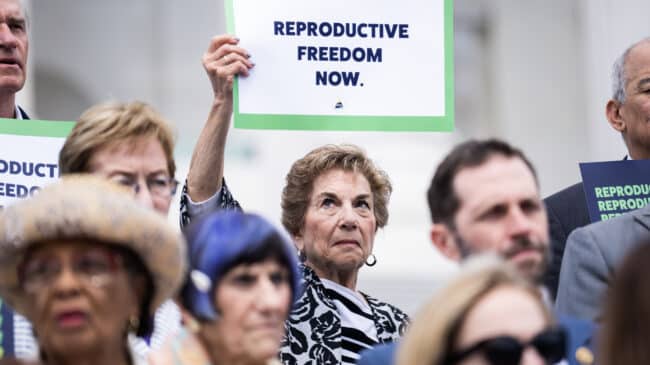Summary
South Dakota Amendment G, the Right to Abortion Initiative, would enshrine a trimester framework for regulating abortion in the state’s bill of rights. Ballotpedia summarizes the proposed amendment’s framework:
- During the first trimester, the state would be prohibited from regulating a woman’s decision to have an abortion;
- During the second trimester, the state may regulate abortion, but “only in ways that are reasonably related to the physical health of the pregnant woman;” and
- During the third trimester, the state may regulate or prohibit abortion, except “when abortion is necessary, in the medical judgment of the woman’s physician, to preserve the life and health of the pregnant woman.”
Abortion in South Dakota is currently banned in all cases except to save the life of the mother, the result of a law passed by the state in 2005 that went into effect when the Supreme Court struck down Roe v. Wade in 2022.
Fiscal Impact
There is no anticipated fiscal impact.
Proponents’ Arguments
Proponents emphasize that relative to the status quo, the amendment would expand abortion rights for South Dakotans and afford the extra layer of protection granted by the state constitution. Former Democratic state lawmaker Nancy Turbak Berry, head of the Freedom Amendment Coalition, rejects South Dakota’s current law as extreme. “It’s about women’s reproductive freedom. We had it. They took it away. We want it back,” she said.
Those supporting the amendment also point to the compromise nature of the trimester framework, which attempts to replicate the framework in Roe. “We’re trying to restore the rights that women have had for the last 50 years. And that’s why we have used the actual language of Roe v. Wade for the amendment,” said South Dakotans for Health Chairman Rick Weiland.
Opponents’ Arguments
Pro-life South Dakotans generally oppose the amendment for the same reasons given by its supporters above. It takes current state law, among the most restrictive of abortion in the nation, restores a framework resembling Roe, and enshrines it in the state constitution.
State Representative John Hansen, R-Dell Falls, who also serves as the co-chair of the Life Defense Fund, said, “This fight is about saving the lives of countless unborn children in our state. We are grateful to the many dedicated volunteers who have put in countless hours, and we are resolute in our mission to defend unborn babies. Hansen and the Life Defense Fund are currently leading a challenge in court of the signatures collected to place the measure on the ballot, which could see it removed. The deadline for printing ballots is Sept. 18.
In addition, several prominent pro-choice groups and leaders either oppose the amendment or have publicly declined to endorse it. These include the ACLU and Planned Parenthood, both of which actively support referendums on amendments to protect abortion rights in other states.
Pro-choice advocates displeased with South Dakota’s amendment say that it does not go far enough to protect abortion rights, with a complicated framework that will be a target for litigation by pro-life groups and a wide scope to restrict abortion written into the amendment.
Tim Stanley, Planned Parenthood North Central States vice-president for communication, said, “Constitutional amendments are serious and expensive undertakings that must be initiated after due diligence and input from those who would be impacted the most.”
Representatives of the ACLU and Planned Parenthood have harshly criticized South Dakotans for Health and Rick Weiland for not consulting their national organizations before drafting and seeking signatures on the amendment.
Discussion
In 2022 and 2023, voters in four states (California, Vermont, Michigan, and Ohio) passed similar measures, while voters in three other states (Kansas, Kentucky, and Montana) defeated measures that would have restricted abortion rights. South Dakota is one of at least six states with abortion-related measures on the 2024 ballot. Whereas most states have written amendments offering absolute protections for abortion rights or only allowing limitations late in the pregnancy, South Dakota’s proposed amendment is relatively uncommon in implementing a more complicated trimester framework detailing when abortion can and cannot be limited by state law.
The South Dakota measure is an initiated constitutional amendment, which required just over 35,000 signatures in 2024 to get on the ballot.
Many ballot initiatives require informed voters to familiarize themselves with details of fiscal policy and regulation that are not usually at the forefront of political debate and on which voters may not have strong opinions when walking into the voting booth. South Dakota’s Right to Abortion Initiative is just the opposite. Most voters nationwide already have pro-choice or pro-life views–often firmly held–and will vote on the measure according to those views.
Unlike in most states where the protection of abortion rights has faced voters, South Dakotans of all views will have to weigh matters of pragmatism and compromise when considering the amendment in addition to the core values that often determine opinions on abortion.
Pro-life South Dakotans largely oppose the amendment. While it goes much less far in protecting abortion rights than virtually any other state proposed state constitutional amendment, it would still represent a dramatic reversal of South Dakota’s near-total ban on abortion currently in place.
For pro-choice South Dakotans, the obvious reason to support the amendment is a return from a virtually outright ban on abortion in the state to a framework intended to be similar to Roe. Against that, they must weigh the concerns of ACLU and Planned Parenthood advocates, who point to dangers in an amendment that would offer extra protection not only to abortion rights but afford similar protection to the right of the legislature to restrict abortion under some situations.
These tensions underscore why the often complicated compromised frameworks common to legislation are not typically employed in constitutional amendments. Ideally, a change in state policy following such a model would be legislated and subsequently amended over time without constitutional concerns. But as in many other states, South Dakotans are expected to lean more pro-choice than their elected legislators, who passed the current ban in 2005.
South Dakota will likely be a legal and political battleground for abortion rights for years to come, whether or not voters affirm the proposed amendment.

